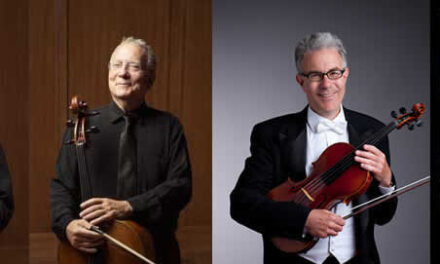The University of North Carolina School of the Arts finished a week full of rehearsals, masterclasses, and concerts with a final recital in Watson Hall to end their inaugural Chamber Music Festival. The concert not only featured UNCSA faculty and students, but also guest artists Paul Neubauer and Jan Vogler in a program comprised of works by Mozart, Fauré, and Mendelssohn.
The night started with a performance of Mozart’s String Quintet in B-flat, K. 174 by Neubauer alongside UNCSA violin students Luca Kevorkian and Marta Đorović, viola student Xue Mei, and cello student Jake Anderson. This piece is classic Mozart – a light, joyous first movement, a simple but lovely slow movement, a bubbly minuet, and a driving finale – meaning that extra care must be taken in interpreting the piece to make it great. The ensemble did just that, with their attention to detail being the most impressive part of the performance. Each phrase, articulation, and dynamic change was perfectly synchronized, which is exactly what is needed to enhance the “classic Mozart” experience.
Then we moved forward about a century for a performance of Fauré’s Piano Quartet No. 1 in C minor, Op. 15, featuring Vogler, UNCSA piano faculty member Dmitri Vorobiev, and violin students Roni Shitrit and Julian Smart. There is no way around it – this piece is just hard. It was incredible to see the fluidity with which the quartet executed the work, but underneath the technical firepower was an emotional, loving interpretation. The almost folklike melody of the first movement is interrupted by grand, sweeping sections that felt like a gust of wind picking me up and carrying me away. The second movement gave the piano its time to shine (which I greatly appreciated) and allowed the strings and piano to bounce off one another, each group uniquely handling similar musical content. The third movement was powerful, played like a lamentation or a sorrowful remembrance of the past, and the finale had the quartet empty their tanks, running (or dancing) to the end while still keeping everything perfectly placed and balanced.
The final performance of the night featured Neubauer, Vogler, faculty members Ida Bieler, Janet Orenstein, Ulrich Eichenauer, and Brooks Whitehouse, and students Raphael Papo and Austin Zhong in Mendelssohn’s String Octet in E-flat, Op. 20. Mendelssohn is an interesting composer in that he straddles the line between what we call the Classical and Romantic styles. Consequently, like Mozart, it is imperative to pay close attention to the details in his music. The octet embraced those details, drawing attention to the Romantic harmonies that interrupted what would otherwise sound like a normal Classical piece. They also masterfully illuminated Mendelssohn’s expert orchestration, as there were multiple sections where a phasing effect was created by shifting melodic material from right to left and vice versa through the instrument groups on stage. The ensemble made it feel as if I was listening to them through stereo headphones, which is not something I had experienced before in a live classical music performance.
Before the concert, Vorobiev – co-Artistic Director of the festival with Bieler – said that these ensembles had been rehearsing since Tuesday. For these groups to have only worked together five days and be able to put on one of UNCSA’s best chamber concerts of the year is awe-inspiring – but that is exactly why the festival was created. Each member of each ensemble faced a great challenge, regardless of if they were a guest artist, faculty member, or student. It certainly speaks to the ability of the guest artists and faculty to quickly adjust to one another, but, more importantly, it speaks to the adaptability and capabilities of UNCSA’s students. Vorobiev said he saw a spark in the students’ eyes when they were tasked with this challenge on Tuesday, and it is that spark that will keep the festival running for many years to come.











